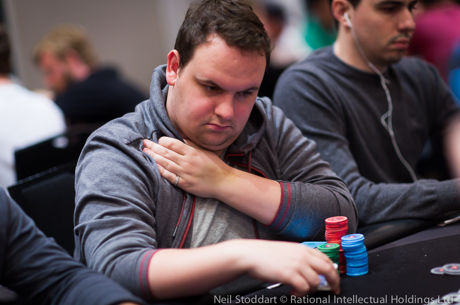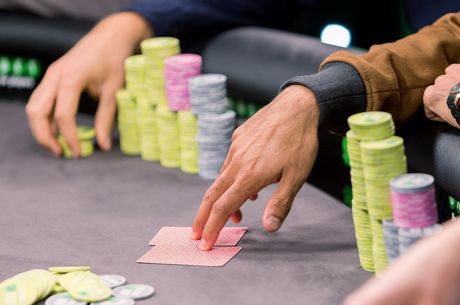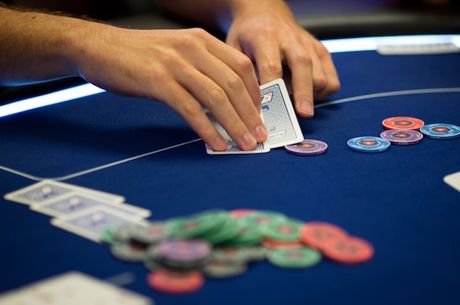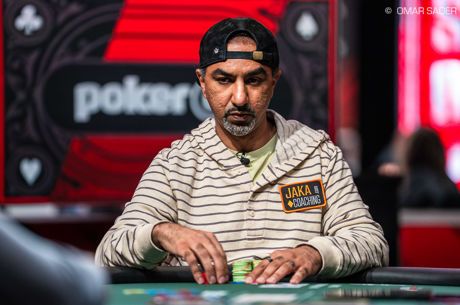10 Tips for Sit & Go Success: Practical Applications of ICM

Last time we introduced the Independent Chip Model and discussed how the concept can be useful to players of sit & gos.
Knowing about ICM can be handy when playing any kind of poker tournament, given the way it helps players take into account payout structures and assign "real money value" to in-hand decisions made over tournament chips. Meanwhile if you play a lot of sit & gos �� especially the standard, single-table SNGs on which we're focusing in this series �� understanding ICM can be especially helpful given the way certain, similar spots in which payouts affect decisions come up time and time again.
When playing poker online, a standard single-table sit & go will typically feature nine players to start (or 10, in some cases) with only the top three spots cashing. Usually 50 percent of the prize pool goes to the winner, 30 percent to the runner-up and 20 percent to the player finishing third. That means finishing fourth through ninth (or 10th), pays the same �� nothing.
As discussed last time, the Independent Chip Model is essentially a complicated formula that determines the "real money value" of each player's chips as indicated by the other players' stacks and the scheduled payouts. The formula takes into account each player's chance of finishing in each of the remaining positions in the tournament, though it doesn't consider things like position or players' relative skill levels.
It's a complicated formula, and to figure out ICM precisely it helps to use an ICM calculator (such as this one). That's not so practical, of course, while you're playing a SNG or in the middle of a hand. In fact, if you're going to play a lot of SNGs, it's worthwhile spending some time away from the tables with an ICM calculator, entering different combinations of stacks and payouts and getting a feel for what the results of different outcomes will be.
We can, however, identify some common situations here for which having even just a rough idea of ICM calculations can help us understand how strategy changes in a sit & go as you progress through the different stages �� early, middle, the bubble and after getting in the money.
ICM: Early Stage
ICM matters most often in sit & gos with all-in confrontations �� those spots where you have to decide whether to take a chance and risk your entire stack or fold and preserve what you have. Let's imagine the same sort of all-in-or-fold decision coming up at different stages of a SNG, using ICM to help show how things change as the sit & go progresses.
We're going to keep things as simple as we can and imagine a rake-free, nine-handed $10 SNG. That means the total prize pool is $90, to be divided $45 (first), $27 (second) and $18 (third). Players start with 1,500 chips. We don't need an ICM calculator to figure out the "real money value" or equity of each chip stack as the first hand is dealt is exactly $10.
Again, to keep things uncomplicated, let's imagine the same sort of situation at each stage of a SNG �� all the stacks are even, and you're being offered a chance to go all in and either double your stack or bust.
So it's the first hand of the tournament and the blinds are 10/20. You're in the big blind with A?K?, and the player in the small blind goes all in holding 2?2?.
You don't know he has deuces, of course, but let's just say that from your perspective you imagine you're being offered a "coin flip." In fact, these two hands are about as close as it gets to a "coin flip" in hold'em, EV-wise �� 50.01 percent (ace-king suited) to 49.99 percent (the deuces).
What's your instinct here? Maybe you're thinking ace-king suited is a hand you can't fold? Or maybe you aren't inclined to go all in on Hand No. 1?
In any case, ICM tells us pretty clearly that it's not a great idea to be flipping for stacks at the beginning of a sit & go like this. Take a look at the values for the different outcomes here:
| Action/Result | Your Chips | ICM "Real Money Value" |
|---|---|---|
| Call and Win | 3,000 | $18.25 |
| Fold | 1,480 | $9.88 |
| Call and Lose | 0 | $0.00 |
As opposed to folding (and losing 12 cents of equity), you'd gain $8.37 if you were to call or win. (Remember, these "real money value" figures as determined by ICM are indications of what you will win on average with a particular stack relative to others' stacks and the payouts.) Meanwhile calling and losing is $9.88 worse than folding.
The practical application of this hypothetical is an understanding that during the early stages of a SNG when all or nearly all of the players are still alive and the stacks are still somewhat close, you needn't be too eager to get your stack in the middle in what appear to be "50-50" spots (or even slightly better). That's because when you do, you gain less when you win than the amount of your loss when you don't.
ICM: Middle Stage
Let's move ahead a little and say there are six players left. Again, we'll keep the stacks all even �� everyone now has 2,250 chips and therefore exactly $15 in equity. It's Level 4, with the blinds 40/80 and an ante of 10.
Again we'll imagine a small blind shove with 2?2? and you're there in the big blind with A?K?. Does being a few spots closer to the money affect your decision? If you avoided doing so before, are you now thinking of calling with ace-king suited? Let's look at the ICM-based values of the outcomes:
| Action/Result | Your Chips | ICM "Real Money Value" |
|---|---|---|
| Call and Win | 4,540 | $25.95 |
| Fold | 2,160 | $14.51 |
| Call and Lose | 0 | $0.00 |
It's still a negative-EV play to flip for your tournament life with six even-stacked players left. Compared to folding (which now loses you nearly 50 cents' worth of equity, thanks to the blinds being bigger), you improve by $11.44 when you win but drop $14.51 when you lose. Being only 50 percent to win here still isn't good enough.
Let's say the small blind-shover was the short stack with 1,250 and you were the chip leader with 3,250 �� would it be worth a call, then? It's a lot closer, actually. Compared to folding, you'd gain $6.27 by calling and winning, but drop only $6.13 by calling and losing.
Incidentally, that's another practical application of ICM, namely, helping inform the strategy to be more willing with a bigger stack both to take chances and to be aggressive. With more chips, you can be the one raising and pressuring short stacks, since ICM affects you less than it does them.
ICM: On the Bubble
Let's move ahead to the bubble �� four players left, only three cash. We'll again start with our contrived scenario in which all four players are even in chips with 3,375 apiece ($22.50 each in equity). Now it's Level 7, and the blinds are 100/200 with a 25 ante.
Once again that maniac to your right is open-pushing from the small blind with his favorite hand, 2?2?, and you again have A?K? in the big blind. It's still not a great idea to accept a 50-50 proposition here. All you have to do is look at the two other players who aren't in the hand to see why.
Both of them would love you to call, as it assures them that no matter what happens they will each make the money.
| Action/Result | Your Chips | ICM "Real Money Value" |
|---|---|---|
| Call and Win | 6,800 | $34.59 |
| Fold | 3,150 | $21.52 |
| Call and Lose | 0 | $0.00 |
Folding loses nearly $1 of equity now (dropping you to $21.52), but calling and winning is only taking you up to $34.59. That's $13.08 better than folding, but that's a lot less than the $21.52 you lose by busting. From a math perspective, you'd need to know you were better than 60 percent to win to entertain such a call, which makes accepting a coin flip a terrible idea.
There are other, more egregious examples of "ICM suicide" that can occur on the bubble, such as when two big stacks tangle with one another and one gets eliminated, allowing the other two short stacks to cash without doing a thing.
ICM: In the Money
Once in the money, everything changes with regard to ICM. In our $10 sit & go with a $90 prize pool, everyone has already locked up $18 (third-place money), meaning there is now only $36 left for which to play.
Also important to keep in mind is the big difference between first ($45) and second ($27). In fact, of the $36 left up for grabs, the winner is getting 75 percent of that ($27) compared to just 25 percent ($9) for the runner-up.
Give the final three players even stacks again �� 4,500 now �� and make it Level 10 (300/600/50). That small blind is shoving against you once more. Calling here and taking a "flip" is significantly more reasonable than it was on the bubble.
With $36 left to play for, each stack is worth $12 in equity before the hand. If you fold, you drop to $10.57. Meanwhile if you call and win, you jump to $21.07. In other words, by winning you gain almost the same amount of equity as you'd lose by busting.
Conclusion
The game of poker can be infinitely complicated, and so by necessity we've narrowed things down a lot here in order to derive a few practical applications of ICM. We've also repeatedly imagined calling a shove rather than raising all in ourselves, although you can turn around the examples and think of how the small blind's all-ins forced us to narrow down significantly the hands with which we could call.
In any event, an awareness of ICM helps players appreciate why it isn't smart to flip for stacks early in a sit & go, nor is it necessarily advisable during the middle stage if the stacks are still close. Meanwhile in some cases it can be disastrous to do so on the bubble, but reasonable when three-handed.
We invented what was on the surface an "even money" situation �� a coin-flip hand to either double up or bust. But thanks to the constantly changing circumstances of a sit & go, what might appear to be a similar situation and decision has to be viewed and understood differently at different stages of the tournament.
Much as an understanding of pot odds can help hold'em players calculate what the most profitable action is to take in a given hand. So, too, can an understanding of ICM help guide players' decision-making at various stages of a sit & go.
Also in this series...
- SNG Pros & Cons
- Assessing Structures and Speeds
- Introducing the Independent Chip Model
- Early Level Play
- Middle Stage Strategy
- On the Money Bubble
- Three-Handed Play
- How To Play Heads-Up
- Managing Your SNG Bankroll
Ready to start giving sit & gos a try? Put these tips into practice at PokerStars.
In this Series
- 1 10 Tips for Sit & Go Success: SNG Pros and Cons
- 2 10 Tips for Sit & Go Success: Assessing Structures and Speeds
- 3 10 Tips for Sit & Go Success: Introducing the Independent Chip Model
- 4 10 Tips for Sit & Go Success: Practical Applications of ICM
- 5 10 Tips for Sit & Go Success: Early Level Play
- 6 10 Tips for Sit & Go Success: Middle Stage Strategy
- 7 10 Tips for Sit & Go Success: On the Money Bubble
- 8 10 Tips for Sit & Go Success: Three-Handed Play
- 9 10 Tips for Sit & Go Success: How To Play Heads-Up
- 10 10 Tips for Sit & Go Success: Managing Your SNG Bankroll









